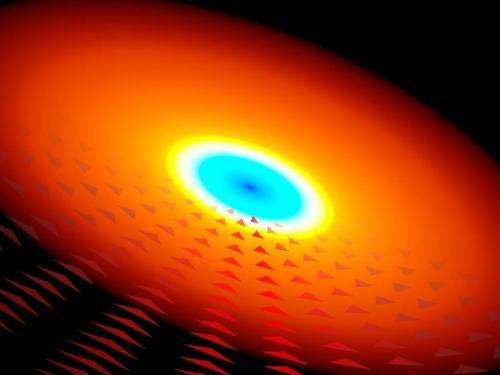New type of black-hole quasar discovered

(Phys.org) —Like our Milky Way, every known large galaxy has at its center a supermassive black hole, some of which are surrounded by a super-bright disk of hot gas called a quasar—but now a research team that includes Penn State astronomers has discovered a surprising new class of quasars in distant galaxies that even the most current theories had not predicted.
"The gas in this new type of quasar is moving in two directions: some is moving toward Earth but most of it is moving at high velocities away from us, possibly toward the quasar's black hole," said study co-author Niel Brandt, Distinguished Professor of Astronomy and Astrophysics at Penn State University. "Just as you can use the Doppler shift for sound to tell if an airplane is moving away from you or toward you, we used the Doppler shift for light to tell whether the gas in these quasars is moving away from Earth or toward these distant black holes, which have a mass from millions to billions of times that of the Sun." Brandt explained. Matter around these black holes forms a quasar disc that is bigger than Earth's orbit around the Sun and hotter than the surface of the Sun. These quasars generate enough light to be seen across the observable universe.
The international research team, led by Patrick Hall of York University in Toronto, Canada, discovered the unusual quasars with data from a large sky survey, the Sloan Digital Sky Survey (SDSS-III). "Matter falling into black holes may not sound surprising," says Hall, "but what we found is, in fact, quite mysterious and was not predicted by current theories." Such gas is found in only about 1 out of 10,000 quasars, and only seventeen cases now are known. This discovery is detailed in a peer-reviewed paper in this month's issue of the journal Monthly Notices of the Royal Astronomical Society, published by Oxford University Press.
In addition to Brandt, the Penn State coauthors of this paper include Graduate Student Nurten Filiz Ak and Distinguished Professor of Astronomy and Astrophysics Donald Schneider, who also is the Survey Coordinator and Scientific Publication Coordinator for SDSS-III. The two specific research components of the Sloan Digital Sky Survey that were used to make this discovery are the SDSS Legacy survey and the SDSS-III Baryon Oscillation Spectroscopic Survey.
"The gas in the disc must eventually fall into the black hole to power the quasar, but what is often seen instead is gas blown away from the black hole by the heat and light of the quasar, heading toward us at velocities up to 20 per cent of the speed of light," Hall said. "If the gas is falling into the black hole, then we don't understand why it's so rare to see infalling gas. There's nothing else unusual about these quasars. If gas can be seen falling into them, why not in other quasars?"
Hall said there is one other possible explanation for these objects. "It could be that the gas moving away from us is not falling into the black hole but is orbiting around it, just above the disc of hot gas, and is very gradually being pushed away from the black hole. A wind like that will show gas moving both toward us and away from us. To make an analogy: imagine an ant on a spinning merry-go-round, crawling from the center to the edge. You will see the ant moving toward you about half the time and away from you about half the time. The same idea could apply to the gas in these quasars. In either case, the gas in these quasars is moving in an unusual fashion."
Models of quasars and their winds will have to be revised to account for these objects. To help understand what revision is needed, the research team is observing these quasars further using Canadian and American access to the Gemini-North telescope in Hawaii.
More information: Paper: mnras.oxfordjournals.org/conte … t/434/1/222.abstract
Journal information: Monthly Notices of the Royal Astronomical Society
Provided by Pennsylvania State University




















